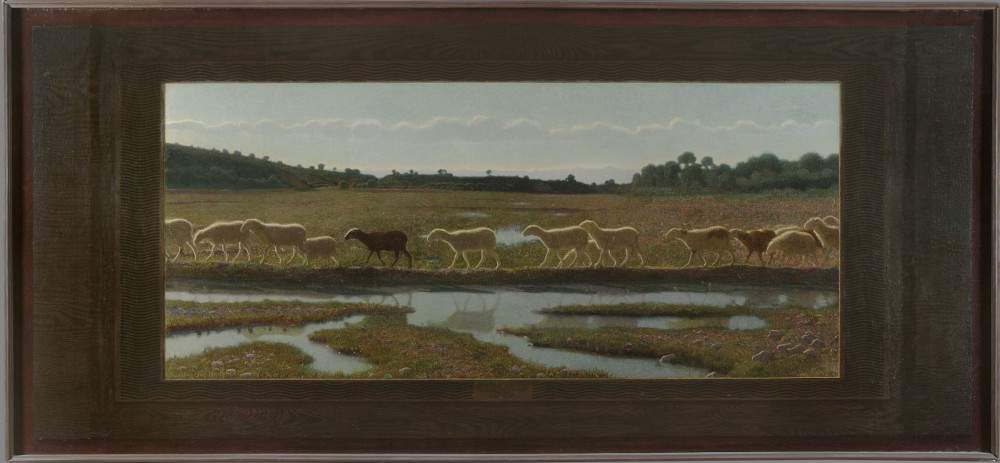Turin's GAM shows its 19th-century collection, from Pellizza da Volpedo to Sartorio
Through April 11, 2023, GAM - Galleria Civica d’Arte Moderna e Contemporanea of Turin presents the exhibition Ottocento. GAM Collections from the Unification of Italy to the Dawn of the Twentieth Century, curated by Riccardo Passoni, director of the Gallery, and Virginia Bertone, chief curator of the collections. The exhibition aims to provide an opportunity to rediscover part of the museum’s 19th-century collection, which has not been on public view for nearly four years now.
On display will be seventy-one works including paintings, pastels, large charcoal drawings, marble sculptures, plaster casts and waxes. In the exhibition itinerary, it will be possible to admire such well-known masterpieces as Antonio Mancini’s After the Duel, Tranquillo Cremona ’s Ivy or Pellizza da Volpedo’s The Mirror of Life, alongside works that have never before been exhibited but were considered very important in the museum’s modern collection in the 19th century, such as Enrico Gamba’s canvas, Behold Jerusalem! or Francesco Gonin’s, Nobles on the Road, which, thanks to research conducted for the exhibition, has regained its history and its true title: The Guide. Study of chestnut trees from life.
Eight thematic sections where the tradition of figure painting is confronted with the novelty of landscape research that was, in its most experimental expressions, the object of harsh criticism from the conservative press and the academic establishment. Topics addressed will be the Birth of a Collection, New Sensibilities and Research, Landscape Painting at the Civic Museum, From Scapigliatura to Divisionism, and Symbolist Research between Painting and Sculpture. In addition, three monographic spaces dedicated to Andrea Gastaldi, Antonio Fontanesi and Giacomo Grosso will be added, aiming to highlight their influence on the Turin art scene also through the significant nuclei of works preserved at GAM.
If the theme of landscape painting is destined to become central to the identity of Turin’s nineteenth-century collection, the exhibition also intends to highlight some unexpected developments in history and figure painting. While still in the mid-nineteenth century, that is, at the time when the GAM collection was formed, this genre was considered the noblest and most valued of all pictorial genres, in the decades immediately following these certainties began to crack and several young artists put themselves to the test with courageous attempts aimed at renewing the tradition of figure painting. Among the most significant cases is La femme de Claude, a large canvas whose real title should have been The Adulteress. Here the young and promising talent of Francesco Mosso, destined to die at only twenty-nine years of age, depicts the modern drama of a young woman victim of her husband’s violence. The subject of controversy and harsh judgments, the painting is a symptom of a different focus on highly topical social issues depicted in an equally new language that would be carefully studied by the Divisionist and Symbolist artists of the late 20th century.
The theme of woman as a subject constitutes another significant track for visiting the exhibition: from being a literary subject of the Romantic age, the female figure becomes over the course of the century the focus of images that are increasingly adherent to contemporary reality. Sometimes they return the hard female conquests that gradually make their role more active in the cultural field, as in the case of the elementary school teacher depicted in Demetrio Cosola’s The Dictation, or they are still mythological creatures but all charged with modern anxieties such as the fascinating Siren drawn by Giulio Aristide Sartorio.
Closing the exhibition is Evangelina Alciati, first graduate of the Royal Academy of Fine Arts in Turin, and her Triste madre: a striking painting that places at the center of the composition a motherhood lived in conditions of extreme poverty.
The exhibition was the occasion for a reconnaissance and study of all the works on display.
In this extensive analysis of GAM’s 19th-century holdings, the Associazione Amici della Fondazione Torino Musei generously contributed by supporting the restorations of Enrico Gamba’s Ecco Gerusalemme, purchased in 1862 at the Società Promotrice delle Belle Arti, and Nobili in viaggio ora La Guida. Study of chestnut trees from life by Francesco Gonin, also acquired in 1867 at the Turin Promotrice Society.
For info: gamtorino.it
Hours: Tuesday through Sunday from 10 a.m. to 6 p.m. Closed Mondays.
Image: Giuseppe Pellizza da Volpedo, Lo specchio della vita (1895-1898, oil on canvas, 132 x 288 cm; Turin, GAM)
 |
| Turin's GAM shows its 19th-century collection, from Pellizza da Volpedo to Sartorio |
Warning: the translation into English of the original Italian article was created using automatic tools. We undertake to review all articles, but we do not guarantee the total absence of inaccuracies in the translation due to the program. You can find the original by clicking on the ITA button. If you find any mistake,please contact us.





























